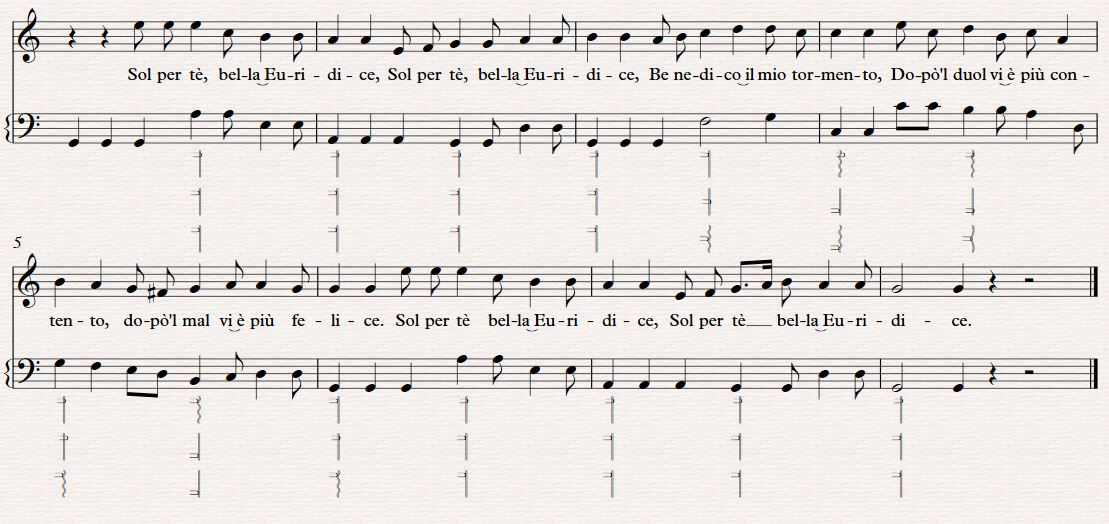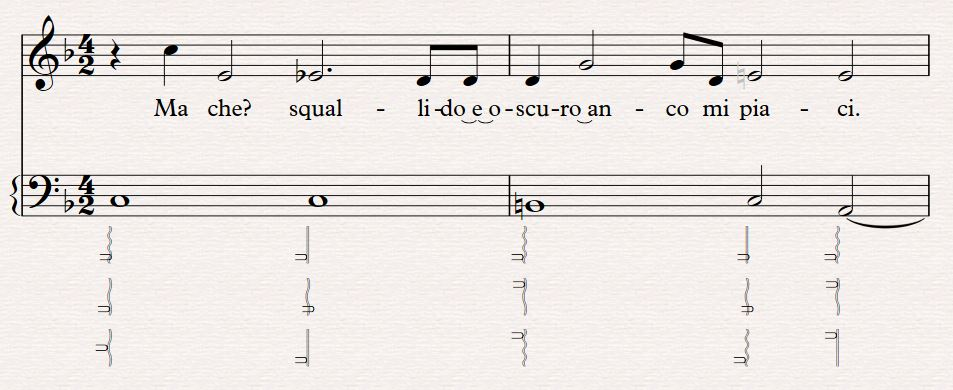5.3 Exercises to Develop Control Through Consistency
Control may also be developed by changing two elements at once, while keeping the third consistent. This is useful in thinking about the elements of timbre as individual but intertwining lines, but also may provoke some lateral thinking in choosing timbral figures through restriction. Figure 5.31 shows the same opening phrase of “Ma Che? Squallido e oscuro” but with three individual exercises.
The first exercise is shown in the top line of timbral notation, staying high in the middle of the strings. This has a sweet sound which suits the intimacy of the first two important words, ‘you’ and Euridice’. For ‘bless my torment’, the gut reaction, put torment low on the string at the soundboard, but that is restricted. Torment is the resolution of sorts, the beat importance is putting the stress on the word ‘benedico’, bless. With that it almost evokes a kind of plagal cadence, with the stress on the subdominant. Benedico, or ‘bless’ is marked as higher on the fingertip for the brighter sound, and then then increased the attack speed on the flesh of the finger for torment, the torment becomes hollow and empty beside the blessing. The challenge is to get more than the sweet, wet sounds inherent to high string position. This is reversed in the next phrase, the tension on ‘sorrow’, and then resolved on content, so I use the faster speed to use the brightness to create tension which is then resolved with a slower attack and more flesh on the finger on ‘content’. For ‘mal’, woe or bad, the faster speed combined with the tip of the finger creates a harder sound, but the tip of the finger gives a brightness to ‘felice’, to ‘lucky’.
For the second version, I used the slower speed, so high on the tip of the finger to get better control of that, and high on the string for the sweetness of Euridice, then lower to give more body to ‘bless’, and low on the string for torment, this is more conventional. For the sorrow/woe and contentment/luck, I used this same low to high timbral resolution, with contentment warmer further down the finger, and keeping the brightness of the tip on luck.
For the third version, I stayed on the tip of my finger. For ‘bless’ I used higher speed and lower position on the strings then sinking for torment, then using the medium height and range for sorrow into the high fast contentment, seeing to create a kind of aura or resonance with the higher speed. The slow, dark, rich sound of ‘woe’ melts into the higher, faster, incorporeal luck.
Visually, in both figures, the distinctions between the notation for the same words and chords are striking, each version has similarities and differences, and reveals different aspects and relationships within the phrasing. In using restrictions like these, I found that I could be pro-active rather than reactive in shaping my realisations, and discovered new colours that I wouldn’t have thought of purely with touch and instinct. It also allows me to shape longer phrases through change rather than at the expense of it, to perceive and control the elements of timbre as phrasing in themselves
This reveals the dual function of this new timbral notation: to create and record more detailed timbral realisations to aid in word painting, and to facilitate in creating timbral exercises of the individual performer's repertoire, exercises centred on the refinement of an individual element through change, or developing cohesion and creative problem solving through consistency. While the notation and these technique are new, they are centred on the descriptions and motivations described in the surviving primary source material, seeking to recreate what was intuitively present within the sound world of the original arpa doppia players. Through these innovations, I seek to use artistic research to bring to life the spectrum of lost practice and technique.
Each of the three lines of timbral notation below the staves keep one element consistent while changing the other two. This gives the harpist a feel for the line of that particular element and forces them to rely on each one to create tension. In the first line, the string height is kept low, so the tension is largely brought about from the body of the attack speed, for example the slower and therefore heavier on ‘squallido’, lighter and faster on ‘oscuro’. In the second line, with the speed kept medium, the tension is more centres on the low to high string height, whereas the third line has a more even variations of both, with the finger contact kept high. This provides a visual reference that there is more than one way to colour the text, and more than one element to provide that colour within the context of the line.
This is a more directly practical technique when realising songs adapting lyric poetry in a strophic form, rather than the freer recitative form of epic poetry. Songs in verses are typically less strictly bound to the text, to realise verses from word to word with high contrast as you would with an epic setting, would likely make it too heavy. As lyric songs are typically contained in a one overriding emotion, repetition both musically and in thematic motif would make constant contrast the expectation rather than eliciting any surprise or emotion from the audience. The challenge is to creating interesting variation without disrupting the flow of the verse. This can be solved, for example, by keeping one element of timbre consistent throughout a verse rather than adapting it from chord to chord.
My example here from Monteverdi’s Orfeo, “Vi Ricorda, O Boschi Ombrosi”1 does have narrative elements, but is contained in the one mood, joy after long sadness. In remembering his past grief, the song still follows the same dancing rhythm and chord progression. To create the variation and the cohesion, I approached exercises for strophic songs from the opposite perspective, rather than controlling an element through changing it, keeping it as a constant while the other elements change.

